Water storage tanks are an integral part of public water systems, providing storage of potable water as well as emergency sources for fire protection. Set high enough above the ground to sufficiently pressurize a water supply system for emergency distribution, these highly visible structures are often cylindrical and painted in neutral or pastel colors. Water storage tanks are readily seen while driving along highways, and often don’t make much of an impression. However, there are some water storage tanks around the world that are quite eye-catching, many of which have been written about. And while these tanks are certainly fascinating, we thought it would be fun to take a look a little closer to home.
The 12 coolest water storage tanks in New England
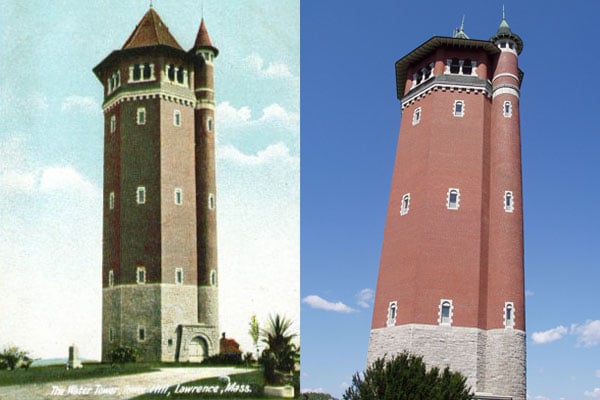
1. Tower Hill Water Tower, Lawrence, MA
The High Service Water Tower, also called Tower Hill Water Tower, was built in 1896 as a high pressure standpipe. The tower, constructed of red brick with granite trim around a steel standpipe, stands 157 feet and was designed by George G. Adams, a noted local architect. The octagonal, Romanesque structure includes a balcony capped by a chateauesque roof, round-arch windows, and a round staircase along one side. It was added to the National Register of Historic Places in 1978 and named a Water Landmark by the American Water Works Association (AWWA) in 1979.
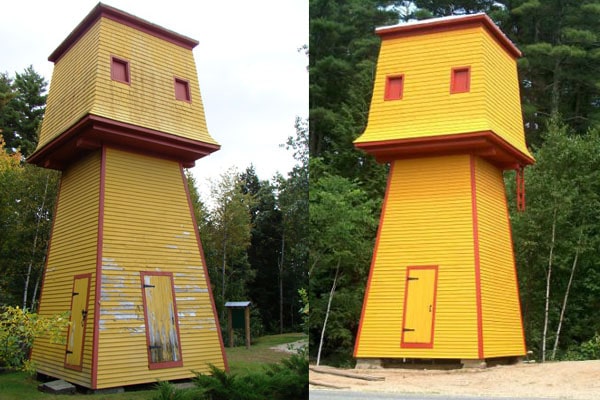
2. Cathance Water Tower, Topsham, ME
The Cathance Water Tower located in Topsham, Maine was built in 1906 to serve the Rogers’ family household and farm. The Tower is 29-feet tall with a 12-foot 4-inch square base and originally held over 5,000 gallons of water. In January 2001, the Cathance Tower was added to the National Register of Historic Places as a locally significant and rare surviving domestic water supply structure. Also in 2001, the Town of Topsham received grant money to restore the Tower, and the restoration was completed in 2005. The stylized structure is essentially unaltered from its original state and is now owned by the Town.
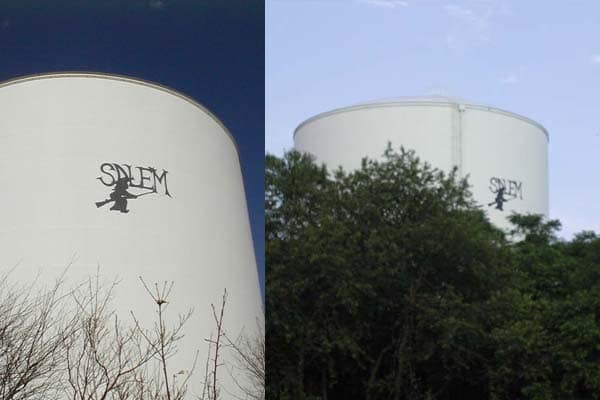
3. Salem, MA
The water storage tank in Salem, MA is rather ordinary save for one very important detail: there is a silhouette of a witch riding on a broomstick painted onto the side of the tank. Salem is well known for its brutal Salem witch trials of 1692, during which 20 innocent people were executed, and to this day Salem gets much of its cultural identity from the trials. During Halloween, Salem attracts thousands of tourists dressed in witchy garb as well as people interested in the paranormal and witchcraft.
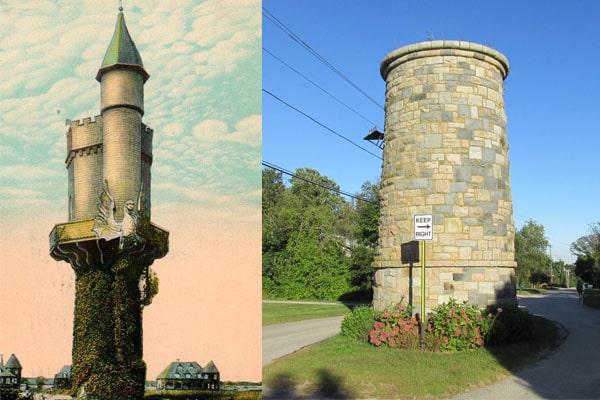
4. Earles Court Tower, Narragansett, RI
The Earles Court Tower was built between 1887-1888 in order to serve the summer community in the popular seaside resort town of Narragansett, Rhode Island. The original tower included a cylindrical stone base upon which was constructed a wooden superstructure that included a balcony and a giant, ornate griffin. In 1928, a strong storm decimated the wooden structure, but the stone base stands to this day. There is currently a grassroots committee of residents who are trying to raise funds to restore the tower to its former glory.
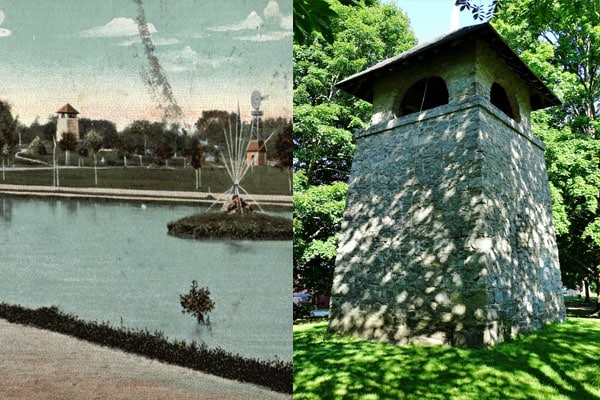
5. Pepperell Park, Saco, ME
The stone water tower in Pepperell Park, Saco, Maine was constructed in 1887 in order to irrigate Pepperell Park. Horace Wadlin, architect of six other buildings in the Biddeford and Saco area including the historic Dyer Library, designed the charming tower, which still exists today but is no longer functional.
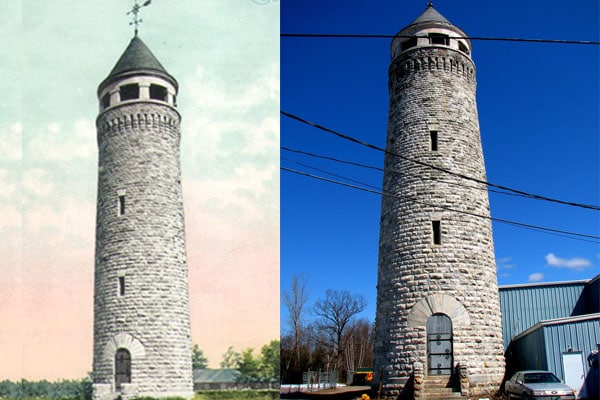
6. Fort Ethan Allen, Essex, VT
The 80-foot tall water tower constructed in 1893 at Fort Ethan Allen was the first of 100 structures to be built at the fort. The tower boasts a 21-foot diameter base that tapers to a conical slate roof that used to be adorned with a weathervane, which has since vanished. The exterior of the tower has stood the test of time remarkably well, as has the intact 50,000-gallon steel tank inside the structure. Because the fort did not have electricity until 1905, water was originally pumped to the tower by steam engines. Unfortunately, the interior circular wooden stairway that winds its way to the observation deck was declared unsafe in 2008, so tours are no longer allowed. There is currently an effort underway to raise an estimated $250,000 to rehab the tower and reopen it to the public.
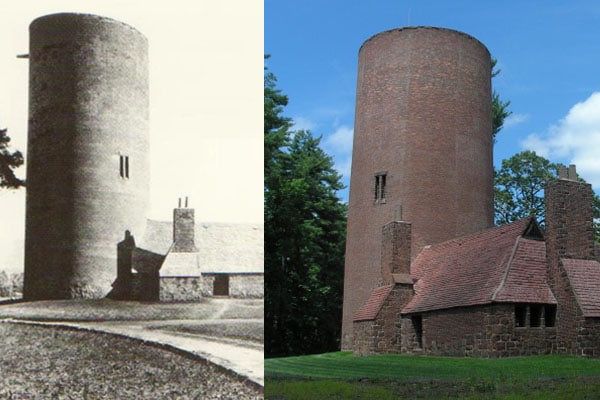
7. Avon Farms School, Avon, CT
The water tower and forge at the entrance to the all-boys Avon Old Farms School in Avon, CT were built in 1922. The English Cotswold and Tudor-styled water tower is cylindrical in shape and constructed of red sandstone and brick, and was operational until 1976 when cisterns were placed underground. It was fully restored in 2012 and now functions as an art gallery and reception venue.
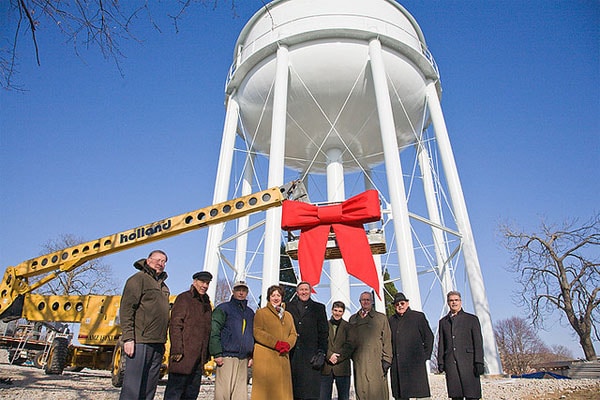
8. Roger Williams University Gift, Bristol, RI
To onlookers, the Bristol, RI water storage tank doesn’t appear to be anything noteworthy. After all, it’s a fairly standard elevated steel tank painted basic white. But what makes this water tower special is how it came to be. During some onsite construction in 2008, Roger Williams University encountered a problem: low water pressure. But instead of bringing in pressure booster pumps to campus and leaving the town to fend for itself, the university decided to donate $1 million to the town for a new water tower. The water tower was constructed in 2009, and on December 30 of that year, it was formally presented to the town at a ceremony — complete with a giant red bow.
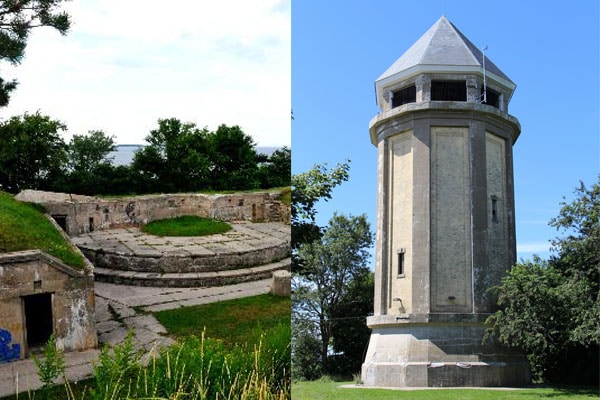
9. Telegraph Hill, Hull, MA
Telegraph Hill is part of Fort Revere Park, a 6-acre historic site located on a small peninsula in the town of Hull, Massachusetts. Telegraph Hill was originally used as a fort in 1776 to defend the port of Boston, and the first telegraph tower was built in 1827. In 1903, the United States Government hired the Hennebique Construction Company to build a 120-foot high, 25-foot diameter reinforced concrete tower housing a 118,000 gallon steel water storage tank to serve Fort Revere. The tower was the first reinforced concrete water tower in New England, and it also served as an observation tower for the Army. The tower was restored in 1975 and was designated an American Water Landmark in 2003. Telegraph Hill was added to the National Register of Historic Places in 1976.
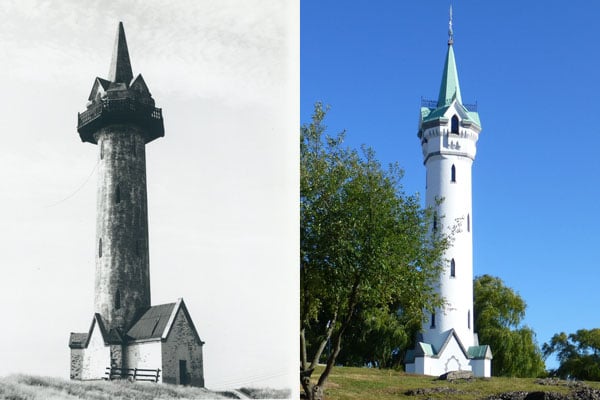
10. Cochituate Standpipe at Fort Hill, Roxbury, MA
Like Telegraph Hill, Fort Hill in Roxbury, Massachusetts was originally used as a fort to defend the area during the Revolutionary War because of its high location. In 1869, the Cochituate Water Company constructed a 130-foot tall brick tower on the site to house an 80-foot tall high pressure water tank and to provide visitors with a clear view of Boston and the surrounding area. The gothic tower, known as the Cochituate Standpipe, is architecturally stunning and in beautiful condition – even the original spiral staircase that wraps around the water tank still remains. The entire neighborhood of Fort Hill, which is sometimes referred to as Highland Park, was listed on the National Register of Historic Places in 1989.
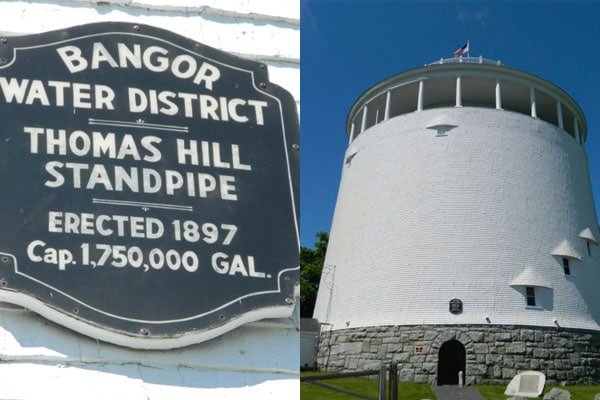
11. Thomas Hill Standpipe, Bangor, ME
The 50-foot tall, 75-foot diameter riveted steel tank, which holds 1.75 million gallons of water, was designed by A.B. Tower of Holyoke, Massachusetts and was constructed in 1897 by the New Jersey Steel and Iron Company atop Thomas Hill in Bangor, Maine. The tank is enclosed by a wooden jacket and has been continually used for its original purpose of regulating the town’s water pressure and providing an emergency source since its construction. Bangor Water District assumed ownership of the standpipe in 1957 and it was added to the National Register of Historic Places in 1974. It is also designated an American Water Landmark by the AWWA. Fun fact: the Thomas Hill Standpipe is within walking distance of renowned author Stephen King’s home, and is commonly believed to be the inspiration for the haunted standpipe in his best-selling novel It.
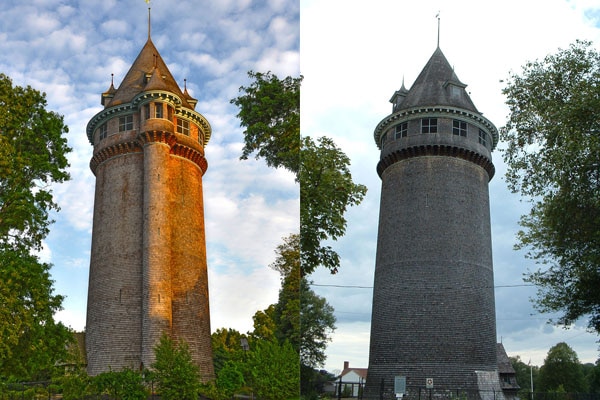
12. Lawson Tower, Scituate, MA
153-foot tall Lawson Tower was constructed in 1902 to hide a 276,000-gallon water tank from the view of Boston multi-millionaire Thomas W. Lawson’s “Dreamworld” estate across the street. Lawson himself paid for the structure, and he spared no expense. The tower was built in the style of a European castle turret with 123 steps to the ornate top, in which there are ten bells ranging in size from 300 to 3,000 pounds. The bells could be played from either the bell room or from a console in the clavier room. The tower is not only aesthetically pleasing but also provides sweeping views of the area, allowing visitors the ability to see all the way to Provincetown on a clear day. It was designated an American Water Landmark by the AWWA in 1974 and was added to the National Register of Historic Places in 1976. The Scituate Water Company stopped using the interior tank in 1988, and the tower is now a popular tourist attraction.
